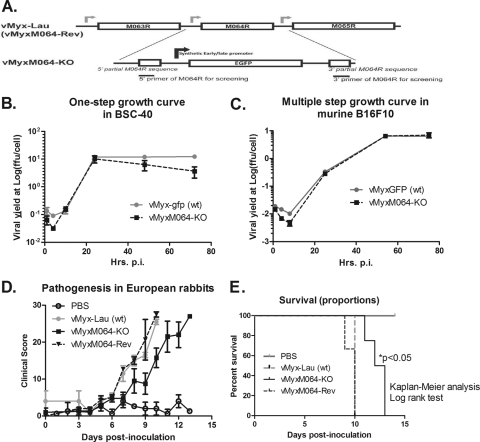Fig 1.
Knocking out M064R from the MYXV genome (vMyxM064R-KO) does not alter the host range tropism of the virus, but it does delay the pathogenic phenotype in vivo. (A) Construct of M064R knockout MYXV. The central region of M064R was replaced by a GFP expression cassette driven by a poxvirus synthetic early/late promoter. A revertant virus was constructed by putting back the intact sequence of M064R. (B) M064R knockout virus replicates very similarly to the wild-type virus in rabbit cells. RK-13 cells were infected at an MOI of 0.1, and cell lysates were harvested at given time points (15, 41, and 67 hours p.i.). Titration was conducted to estimate viral yields. (C) M064R knockout virus replicates similarly to the wild-type virus in murine B16F10 cells. Infection was conducted at an MOI of 0.5, and at given time points (1, 4, 8, 25, 54, and 75 h p.i.) the cell lysates were harvested for titration to estimate the viral yield. (D) M064R knockout virus showed a delayed development of myxomatosis in European rabbits. Four groups of animals were intradermally inoculated with vehicle (PBS only), 1,000 FFU of vMyx-Lau (wt), vMyxM064-KO, or vMyxM064-Rev (revertant virus). Pathogenesis was evaluated daily for each animal using a clinical score system, and the average score of each group is shown in the graph. The error bars represent the standard error of the mean (SEM). (E) M064R knockout virus infection led to a significantly delayed pathogenesis. From the same set of experiments as those shown in panel D, the survival of animals from each group was evaluated. Statistical analysis was conducted using Kaplan-Meier analysis followed by a log rank test, and a P value of <0.05 is defined as statistically significant.

